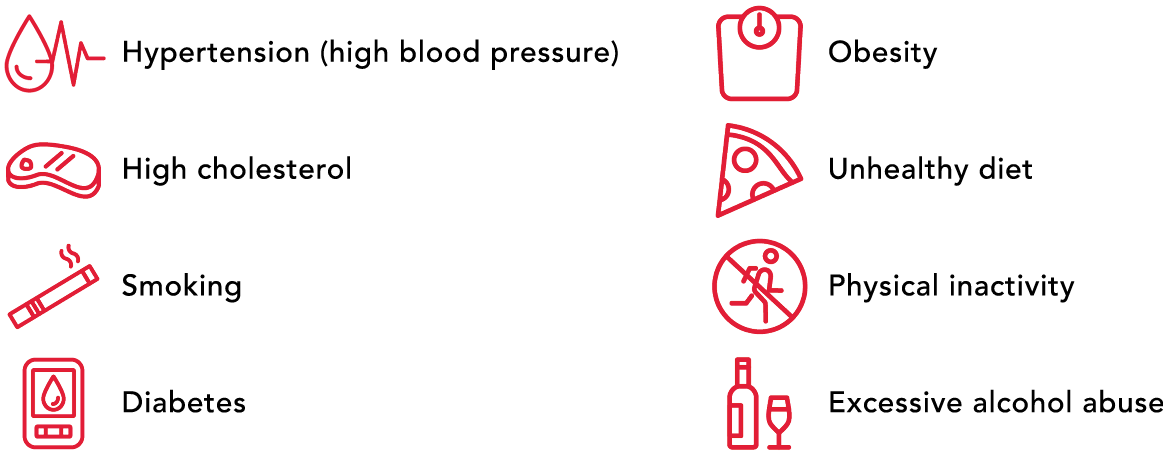
Published March 2021
Though American Heart Month is in February, it is important to recognize heart health and the impact of heart disease within our communities year-round. When it comes to heart disease in the United States, the statistics speak volumes. As the leading cause of death for men, women and people of most racial and ethnic groups, heart disease is responsible for one in four deaths every year, and one death every 36 seconds.
While the risk of heart disease is high for all Americans, that danger is exponentially higher for the Black community. Heart disease accounts for one-third of the disparity in potential life-years lost between Black and white individuals–an imbalance linked to a combination of factors including income, education, genetic and physiological determinants, access to care and communication barriers.
Here we break down the disparities and risk factors of heart disease, as well as heart-healthy tips to help you improve and maintain cardiovascular health.
Inequities by the Numbers
The following statistics from the American Heart Association show how heart disease disproportionately impacts Black and ethnic communities:
- The death rate of heart disease is 33% higher for Black Americans than it is for the overall U.S. population.
- American Indians and Alaska Natives die from heart disease much earlier than expected–36% are under age 65 compared to only 17% of the overall U.S. population.
- Non-Hispanic Blacks and Mexican American women have a higher rate of obesity than non-Hispanic White women.
- Non-Hispanic Blacks, Mexican-Americans, American Indians and Alaska Natives have a higher prevalence of diabetes than non-Hispanic White adults over age 20.
- High blood pressure is more common in certain racial and ethnic minority groups in the U.S., especially Blacks.
Risk Factors for Heart Disease
Heart disease, also known as cardiovascular disease (CVD), refers to a variety of cardiac conditions including stroke, heart failure, aorta disease, coronary artery disease, arrhythmia, vascular disease and high blood pressure. Certain medical conditions, lifestyle choices and circumstances can put people at higher risk for heart disease, and oftentimes they disproportionately impact people of color. Among the most common risk factors are:

Working Toward a Heart-Healthier Future
When it comes to the imbalance of heart disease for minority groups, inaccessibility to nutritious food is a major underlying issue. To help address this, the Harvard Pilgrim Health Care Foundation partners with local non-profits, health centers and small businesses to bring fresh, healthy food to vulnerable neighborhoods in the communities we serve. And particularly during the pandemic, the Foundation provides healthy prepared meals and fresh produce weekly to hundreds of at-risk families across New England with the help of community leaders and dedicated volunteers
Preventing Heart Disease with Mindful Eating
Over the course of one year, almost half of heart disease-related deaths were linked to a poor diet. To help build better eating habits for your heart and overall health, follow these mindful eating tips from the American Heart Association:
![]()
Ponder. Before you eat, check in with yourself. Are you really hungry or could you be experiencing another feeling, like thirst, boredom or stress?
![]()
Appraise. Pause to evaluate the snack or dish in front of you. How does the smell make you feel? Do you really want it? Is the portion more than you need?
![]()
Slow. Eat slowly so your brain can keep up with your stomach. Set your fork down in between bites and focus on the taste as you chew.
![]()
Savor. Remember to enjoy. Take a moment between bites to immerse yourself in the flavors and textures.
![]() Stop. Once you’re satisfied or full, stop eating. Save it for later rather than force yourself to overeat just to clean your plate.
Stop. Once you’re satisfied or full, stop eating. Save it for later rather than force yourself to overeat just to clean your plate.
Prioritizing the ABCs of Heart Health
While the current state of heart disease in the U.S. may seem discouraging, the good news is that 80% of premature heart disease and strokes are preventable. Help you and your loved ones maintain a healthy cardiovascular system by keeping the ABCs top of mind:

Committing to a healthy cardiovascular system means committing to a healthy lifestyle, including staying physically active and managing stress. For Harvard Pilgrim members, learn more about member discounts and savings and login for tools and resources that make it even easier to take care of your overall well-being. And for members and non-members alike, check out Harvard Pilgrim’s Living Well Everyday program to access nutrition and fitness tips, including free online virtual classes like Zumba, yoga and mindfulness sessions.
To confirm eligibility for any programs or services mentioned in this article as it relates to your specific health plan, please reach out to your account executive or HR benefits team. You may also speak to our member services team at (888)-333-4742 or by sending a secure email. And for plan details and other member resources, log in to the member portal.